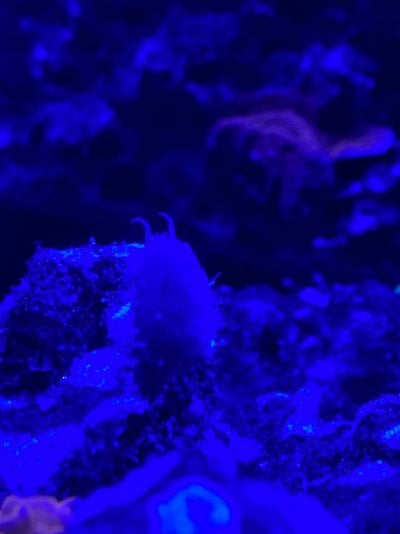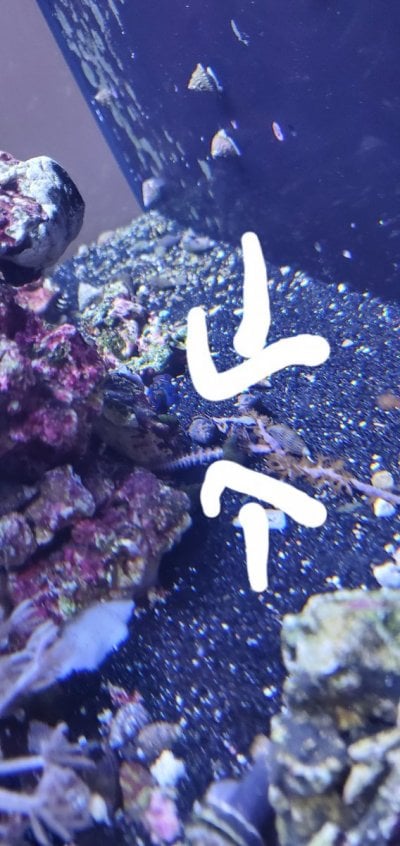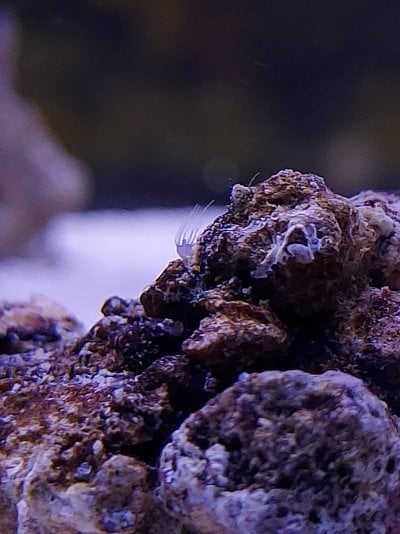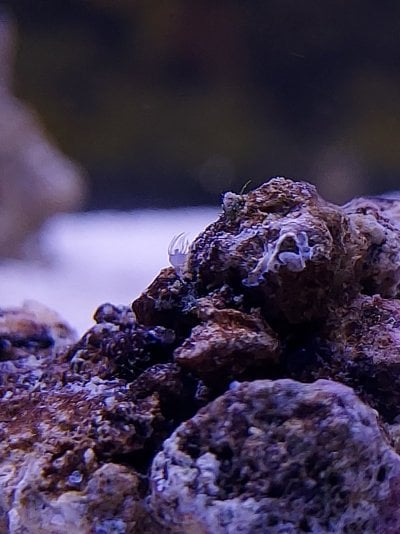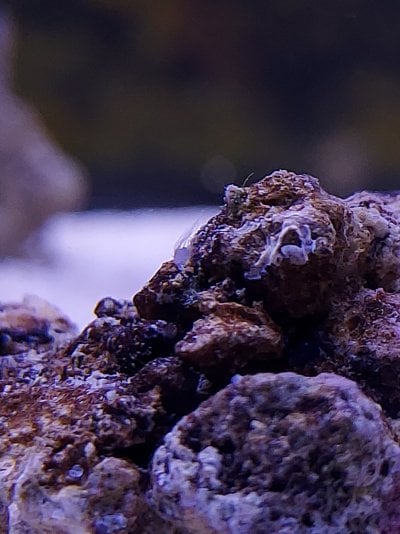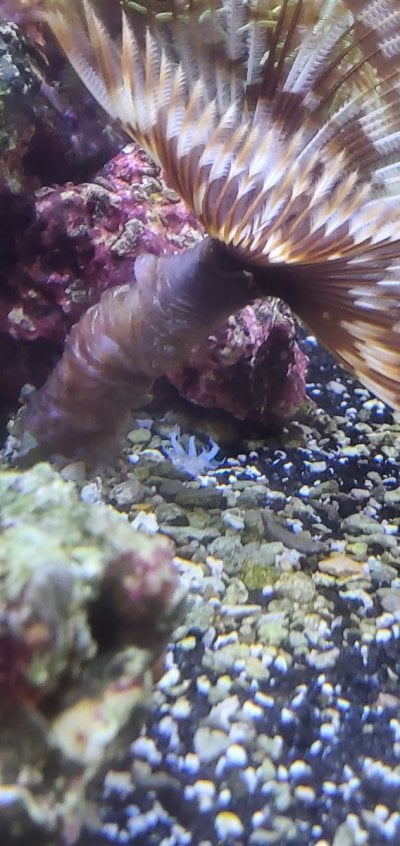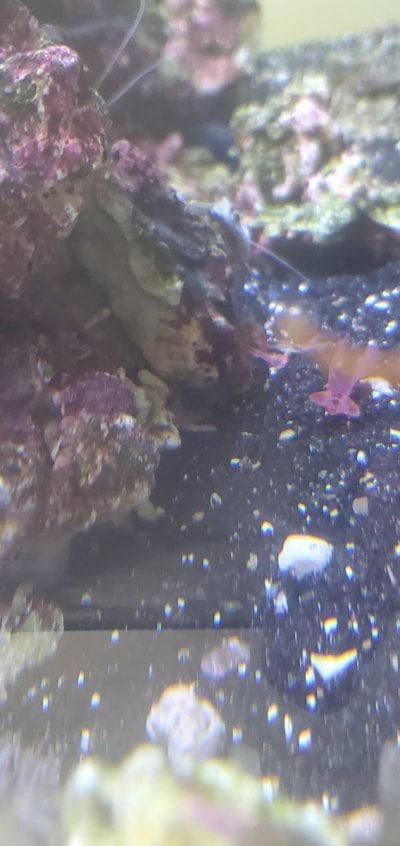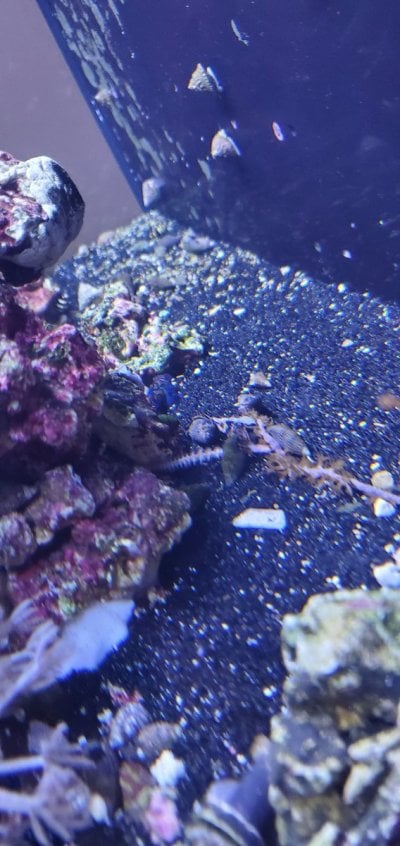Navigation
Install the app
How to install the app on iOS
Follow along with the video below to see how to install our site as a web app on your home screen.
Note: This feature may not be available in some browsers.
More options
You are using an out of date browser. It may not display this or other websites correctly.
You should upgrade or use an alternative browser.
You should upgrade or use an alternative browser.
What is that!! A R2R guide to common new tank hitchhikers.
- Thread starter Crabs McJones
- Start date
- Tagged users None
There are little snail like that live in the sand .
Sometimes you only see their one tentacle poking out of the sand .
I have got a mantis shrimp as a hitch hiker . Acro crabs are they all good ?
Sometimes you only see their one tentacle poking out of the sand .
I have got a mantis shrimp as a hitch hiker . Acro crabs are they all good ?
What is it?
Any ideas?Any idea what this is?
Shows up when lights go out and is basically in the same area of the tank
- Joined
- Jul 18, 2019
- Messages
- 52
- Reaction score
- 11
One of the greatest things about starting a reef tank is getting your live rock in and admiring all the diversity within it. The rock comes to life different creatures. This is a guide that I, along with a very well known critter identifier @KJ , have put together for the new reefer on what these hitchhikers are and whether they're a keeper or to pull them out.
Bristleworm -
Very common good hitchhiker. The jury is out on whether they're beneficial or not. Most consider them a vital part of your clean up crew. The hide within your live rock, coming out to pick up scraps of food and other detritus. Their numbers can become overwhelming based off how much food is available in the tank. If you overfeed, and they have access to an abundance of food, their numbers will increase dramatically. Be careful not to touch as the bristles on the sides of their bodies can be very irritating and cause an allergic reaction in some.
Fireworm -
Bad hitchhiker. Similar to the bristle worm, however if stung by the bristles on this little guy, its 10 times worse. DO NOT TOUCH UNDER ANY CIRCUMSTANCES! If found it is best to remove with a trap.
Pineapple Sponges -
Very common good hitchhiker. These little guys are a type of sponge. They are most commonly found in overflows and in high flow areas of the sump. However, they can sometimes bee seen in shaded areas of your rockwork.
Asterina Starfish -
Another common neutral hitchhiker. Jury is out on these guys as to good or bad. Some people love them, some hate them. They've been rumored to munch on coralline algae. They are also known to multiply very rapidly. Manual removal when seen is best to control their numbers.
Aiptasia -
Bad hitchhiker. This is a type of anemone that multiplies very quickly, and stings and kills anything that gets near it. Depended on how many you have, they're best removed by manually scraping them off the rock, and then using epoxy/superglue/kalk paste over where they were to prevent them coming back. A few predators that you can get for them include the peppermint shrimp, berghia nudibranch, and with a large enough tank, copperband butterflyfish.
Majano -
Bad Hitchhiker. This is another pest anemone that multiplies quickly and stings anything near it. Best removed by manual scraping off and super glue/epoxy/kalk past over its spot. Peppermint shrimp will reportedly consume them as well.
Vermedit Snail -
Very common neutral hitchhiker. They are generally harmless, but can multiply quickly based off nutrients in the tank, and can irritate corals. Manual removal or starving them out by putting a dab of superglue on the end of the tube is best to keep their numbers in check, as well as nutrient control.
Spirorbid Worm -
Very common neutral hitchhiker. These guys are most commonly found in overflows, and high flow areas of your sump. Can multiply very quickly and have been rumored to disrupt equipment such as pumps. Nutrient control keeps their numbers in check.
Ball Anemone -
Common neutral hitchhiker. They are found in shaded areas of live rock, and tend to not bother anything and numbers are kept in check with nutrient control. Are removed by the same means as the aiptasia and majano.
Stomatella Snail -
Very good hitchhiker. These guys are a great clean up crew member. They can be very elusive and most commonly found after lights out and are very fast moving. They feed off different algae in the tank.
Copepod/Isopod/Amphipod -



Very good hitchhikers. Often referred to as simply "pods" These little guys live within your rock work and make great food for your fish and corals. They can be the primary diet of certain mandarins.
Spaghetti Worm -
Good hitchhiker. Commonly found in the sand bed or live rock. They extend out multiple tentacles to catch floating detritus. Good member of your clean up crew.
Hydroids -

Bad hitchhikers. Good news is that they don't tend to live very long and die off on their own as the tank progresses.
Sponges -
Good hitchhiker. Very common filter feeders. Found in shaded areas of live rock
Serpent And Brittle Starfish -

Good hitchhikers. Are most commonly found by the arms extending out from cracks and holes in rock work. Feed off leftover food and detritus in the tank.
Bobbit Worm -
Very bad hitchhiker. These guys can grow to be very large and can kill fish. Most common means of removal is to remove the entire rock where the worm is housed. Be careful of the pincer teeth at the head of the worm.
Tunicate -
Good hitchhiker. Harmless filter feeder. At first glance looks like a sponge, except it pulses as it takes in and expels water, and reacts to touching it.
Limpet -
Good hitchhiker. Consumes algae. Don't seem to bother anything.
Chiton -
Good hitchhiker. Consumes algae. Does not appear to bother anything.
Peanut Worm -
Good hitchhiker. Lives in live rock and feeds off of extra food and detritus.
Gorilla Crab -
Bad hitchhiker. Can be found in live rock cracks, caves and holes. They are predatory and will hunt your shrimp and inverts. They can also grow rather large.
Benthic Ctenophores -
Been seeing this one pop up more and more lately, so I figured why not add them to the list.
They are a neutral hitchhiker. They mainly filter feed on zooplankton and small particulates in the water. Most commonly referred to as comb jellys.
Red Planaria Flatworm -
Bad Hitchiker. While they don't consume any coral, they can grow in numbers to the point where they smother coral. Caution should be taken as when these die off they release toxins that can wipe out a tank quickly.
Ghost Flatworm -
Neutral hitchiker. Doesn't harm anything. But does consume pods
Acoel Flatworm -
Neutral Hitchiker. Doesn't harm anything, however can grow greatly in numbers quickly
Polyclad Flatworm -
Bad Hitchhiker. Predatory towards clams and coral depended on subspecies.
Pumpkin Flatworm (Waminoa Sp)
Bad Hitchiker. Predatory. Can smother and kill LPS corals.
Acropora Eating Flatworm -
Bad Hitchiker. See name
I did not cover Nudibranch or snails in this thread as there are far to many variations to cover. If you have an unknown, please create a thread or post it in this thread and we'll try our best to ID it for you. If you have any additions to the list please PM me and I'll review it and add to the list.
- Joined
- Jul 18, 2019
- Messages
- 52
- Reaction score
- 11
Can anyone ID? Looks like a bristleworm, but its white! Was fighting a hermit for a piece of mysis. Sorry couldn't get a better picture. Tried to draw an arrow. Thanks!!
One of the greatest things about starting a reef tank is getting your live rock in and admiring all the diversity within it. The rock comes to life different creatures. This is a guide that I, along with a very well known critter identifier @KJ , have put together for the new reefer on what these hitchhikers are and whether they're a keeper or to pull them out.
Bristleworm -
Very common good hitchhiker. The jury is out on whether they're beneficial or not. Most consider them a vital part of your clean up crew. The hide within your live rock, coming out to pick up scraps of food and other detritus. Their numbers can become overwhelming based off how much food is available in the tank. If you overfeed, and they have access to an abundance of food, their numbers will increase dramatically. Be careful not to touch as the bristles on the sides of their bodies can be very irritating and cause an allergic reaction in some.
Fireworm -
Bad hitchhiker. Similar to the bristle worm, however if stung by the bristles on this little guy, its 10 times worse. DO NOT TOUCH UNDER ANY CIRCUMSTANCES! If found it is best to remove with a trap.
Pineapple Sponges -
Very common good hitchhiker. These little guys are a type of sponge. They are most commonly found in overflows and in high flow areas of the sump. However, they can sometimes bee seen in shaded areas of your rockwork.
Asterina Starfish -
Another common neutral hitchhiker. Jury is out on these guys as to good or bad. Some people love them, some hate them. They've been rumored to munch on coralline algae. They are also known to multiply very rapidly. Manual removal when seen is best to control their numbers.
Aiptasia -
Bad hitchhiker. This is a type of anemone that multiplies very quickly, and stings and kills anything that gets near it. Depended on how many you have, they're best removed by manually scraping them off the rock, and then using epoxy/superglue/kalk paste over where they were to prevent them coming back. A few predators that you can get for them include the peppermint shrimp, berghia nudibranch, and with a large enough tank, copperband butterflyfish.
Majano -
Bad Hitchhiker. This is another pest anemone that multiplies quickly and stings anything near it. Best removed by manual scraping off and super glue/epoxy/kalk past over its spot. Peppermint shrimp will reportedly consume them as well.
Vermedit Snail -
Very common neutral hitchhiker. They are generally harmless, but can multiply quickly based off nutrients in the tank, and can irritate corals. Manual removal or starving them out by putting a dab of superglue on the end of the tube is best to keep their numbers in check, as well as nutrient control.
Spirorbid Worm -
Very common neutral hitchhiker. These guys are most commonly found in overflows, and high flow areas of your sump. Can multiply very quickly and have been rumored to disrupt equipment such as pumps. Nutrient control keeps their numbers in check.
Ball Anemone -
Common neutral hitchhiker. They are found in shaded areas of live rock, and tend to not bother anything and numbers are kept in check with nutrient control. Are removed by the same means as the aiptasia and majano.
Stomatella Snail -
Very good hitchhiker. These guys are a great clean up crew member. They can be very elusive and most commonly found after lights out and are very fast moving. They feed off different algae in the tank.
Copepod/Isopod/Amphipod -



Very good hitchhikers. Often referred to as simply "pods" These little guys live within your rock work and make great food for your fish and corals. They can be the primary diet of certain mandarins.
Spaghetti Worm -
Good hitchhiker. Commonly found in the sand bed or live rock. They extend out multiple tentacles to catch floating detritus. Good member of your clean up crew.
Hydroids -

Bad hitchhikers. Good news is that they don't tend to live very long and die off on their own as the tank progresses.
Sponges -
Good hitchhiker. Very common filter feeders. Found in shaded areas of live rock
Serpent And Brittle Starfish -

Good hitchhikers. Are most commonly found by the arms extending out from cracks and holes in rock work. Feed off leftover food and detritus in the tank.
Bobbit Worm -
Very bad hitchhiker. These guys can grow to be very large and can kill fish. Most common means of removal is to remove the entire rock where the worm is housed. Be careful of the pincer teeth at the head of the worm.
Tunicate -
Good hitchhiker. Harmless filter feeder. At first glance looks like a sponge, except it pulses as it takes in and expels water, and reacts to touching it.
Limpet -
Good hitchhiker. Consumes algae. Don't seem to bother anything.
Chiton -
Good hitchhiker. Consumes algae. Does not appear to bother anything.
Peanut Worm -
Good hitchhiker. Lives in live rock and feeds off of extra food and detritus.
Gorilla Crab -
Bad hitchhiker. Can be found in live rock cracks, caves and holes. They are predatory and will hunt your shrimp and inverts. They can also grow rather large.
Benthic Ctenophores -
Been seeing this one pop up more and more lately, so I figured why not add them to the list.
They are a neutral hitchhiker. They mainly filter feed on zooplankton and small particulates in the water. Most commonly referred to as comb jellys.
Red Planaria Flatworm -
Bad Hitchiker. While they don't consume any coral, they can grow in numbers to the point where they smother coral. Caution should be taken as when these die off they release toxins that can wipe out a tank quickly.
Ghost Flatworm -
Neutral hitchiker. Doesn't harm anything. But does consume pods
Acoel Flatworm -
Neutral Hitchiker. Doesn't harm anything, however can grow greatly in numbers quickly
Polyclad Flatworm -
Bad Hitchhiker. Predatory towards clams and coral depended on subspecies.
Pumpkin Flatworm (Waminoa Sp)
Bad Hitchiker. Predatory. Can smother and kill LPS corals.
Acropora Eating Flatworm -
Bad Hitchiker. See name
I did not cover Nudibranch or snails in this thread as there are far to many variations to cover. If you have an unknown, please create a thread or post it in this thread and we'll try our best to ID it for you. If you have any additions to the list please PM me and I'll review it and add to the list.
Attachments
This one is kinda hard to get a pic of as its super small. I've had aiptasia and I'm kinda worried that these are babies. I've removed them before but I probably found another dozen today.
Any ideas on what they are?
Any ideas on what they are?
Attachments
Crabs McJones
I'm so shi-nay
View Badges

Excellence Award
Reef Tank 365
Article Contributor
Moderator Emeritus
Hospitality Award
Reef Tank 365 Boss
Wisco Reefers
My Tank Thread
Looks more like a colonial hydroidThis one is kinda hard to get a pic of as its super small. I've had aiptasia and I'm kinda worried that these are babies. I've removed them before but I probably found another dozen today.
Any ideas on what they are?
vetteguy53081
Well known Member and monster tank lover
View Badges
Partner Member 2024
Excellence Award
Reef Tank 365
RGB
Article Contributor
Tampa Bay Reef Keepers
West Palm Beach Reefer
Hospitality Award
Ocala Reef Club Member
305 Reef Club
Wisco Reefers
Midwest Reefer
Fish Medic
MAC of SW Florida
Rock Pool Reef Keepers
R2R Secret Santa 2023
My Tank Thread
My Aquarium Showcase
I agree on droid which is capable of stinging nearby coral. best method is to starve it and it will dissintegrate. They favor brine shrimp but catch suspended foods for survival. Aim water flow Towards them- Not at them and they will have no way to obtain food.
Other method is a dab of super glue gel on the core and they are done.
Other method is a dab of super glue gel on the core and they are done.
Had this cool little worm thing going around on one of my live rocks been monitoring it seems to be not bothered by the lights being on and its been chowing down on some green algae

vetteguy53081
Well known Member and monster tank lover
View Badges
Partner Member 2024
Excellence Award
Reef Tank 365
RGB
Article Contributor
Tampa Bay Reef Keepers
West Palm Beach Reefer
Hospitality Award
Ocala Reef Club Member
305 Reef Club
Wisco Reefers
Midwest Reefer
Fish Medic
MAC of SW Florida
Rock Pool Reef Keepers
R2R Secret Santa 2023
My Tank Thread
My Aquarium Showcase
Dorvillidae worm and eats algae and detritus
Why do you think they are killing your fish? How many do you have? Tons of people keep pistol shrimp (myself included) without issue.Should pistol shrimp be added to this? I think mine are killing my fish. And I hear them clicking pretty often.
Came home from work today and saw a bunch of white spots on my glass and rocks, as well as many floating around. Thought they were snail eggs, but not sure. Took as good a pic as I could of one on the glass.
 Any help IDing would be greatly appreciated.
Any help IDing would be greatly appreciated.
vetteguy53081
Well known Member and monster tank lover
View Badges
Partner Member 2024
Excellence Award
Reef Tank 365
RGB
Article Contributor
Tampa Bay Reef Keepers
West Palm Beach Reefer
Hospitality Award
Ocala Reef Club Member
305 Reef Club
Wisco Reefers
Midwest Reefer
Fish Medic
MAC of SW Florida
Rock Pool Reef Keepers
R2R Secret Santa 2023
My Tank Thread
My Aquarium Showcase
These are spirobid worms and harmless generally on the glass. You can remove into a net using the edge of an old credit cardCame home from work today and saw a bunch of white spots on my glass and rocks, as well as many floating around. Thought they were snail eggs, but not sure. Took as good a pic as I could of one on the glass.Any help IDing would be greatly appreciated.
Thanks for the info. If they are harmless I will just leave them be. I love all the life that is springing up!!These are spirobid worms and harmless generally on the glass. You can remove into a net using the edge of an old credit card
- Joined
- Jul 18, 2019
- Messages
- 52
- Reaction score
- 11
Hey all! I believe this is aptasia. Can anyone confirm in the first pic? Also not a great pic, but I have a white/pink worm that slightly comes out of my LR. Is that a bristleworm? Its sticking out near the cave right near my fire shrimp molt. Thanks!One of the greatest things about starting a reef tank is getting your live rock in and admiring all the diversity within it. The rock comes to life different creatures. This is a guide that I, along with a very well known critter identifier @KJ , have put together for the new reefer on what these hitchhikers are and whether they're a keeper or to pull them out.
Bristleworm -
Very common good hitchhiker. The jury is out on whether they're beneficial or not. Most consider them a vital part of your clean up crew. The hide within your live rock, coming out to pick up scraps of food and other detritus. Their numbers can become overwhelming based off how much food is available in the tank. If you overfeed, and they have access to an abundance of food, their numbers will increase dramatically. Be careful not to touch as the bristles on the sides of their bodies can be very irritating and cause an allergic reaction in some.
Fireworm -
Bad hitchhiker. Similar to the bristle worm, however if stung by the bristles on this little guy, its 10 times worse. DO NOT TOUCH UNDER ANY CIRCUMSTANCES! If found it is best to remove with a trap.
Pineapple Sponges -
Very common good hitchhiker. These little guys are a type of sponge. They are most commonly found in overflows and in high flow areas of the sump. However, they can sometimes bee seen in shaded areas of your rockwork.
Asterina Starfish -
Another common neutral hitchhiker. Jury is out on these guys as to good or bad. Some people love them, some hate them. They've been rumored to munch on coralline algae. They are also known to multiply very rapidly. Manual removal when seen is best to control their numbers.
Aiptasia -
Bad hitchhiker. This is a type of anemone that multiplies very quickly, and stings and kills anything that gets near it. Depended on how many you have, they're best removed by manually scraping them off the rock, and then using epoxy/superglue/kalk paste over where they were to prevent them coming back. A few predators that you can get for them include the peppermint shrimp, berghia nudibranch, and with a large enough tank, copperband butterflyfish.
Majano -
Bad Hitchhiker. This is another pest anemone that multiplies quickly and stings anything near it. Best removed by manual scraping off and super glue/epoxy/kalk past over its spot. Peppermint shrimp will reportedly consume them as well.
Vermedit Snail -
Very common neutral hitchhiker. They are generally harmless, but can multiply quickly based off nutrients in the tank, and can irritate corals. Manual removal or starving them out by putting a dab of superglue on the end of the tube is best to keep their numbers in check, as well as nutrient control.
Spirorbid Worm -
Very common neutral hitchhiker. These guys are most commonly found in overflows, and high flow areas of your sump. Can multiply very quickly and have been rumored to disrupt equipment such as pumps. Nutrient control keeps their numbers in check.
Ball Anemone -
Common neutral hitchhiker. They are found in shaded areas of live rock, and tend to not bother anything and numbers are kept in check with nutrient control. Are removed by the same means as the aiptasia and majano.
Stomatella Snail -
Very good hitchhiker. These guys are a great clean up crew member. They can be very elusive and most commonly found after lights out and are very fast moving. They feed off different algae in the tank.
Copepod/Isopod/Amphipod -



Very good hitchhikers. Often referred to as simply "pods" These little guys live within your rock work and make great food for your fish and corals. They can be the primary diet of certain mandarins.
Spaghetti Worm -
Good hitchhiker. Commonly found in the sand bed or live rock. They extend out multiple tentacles to catch floating detritus. Good member of your clean up crew.
Hydroids -

Bad hitchhikers. Good news is that they don't tend to live very long and die off on their own as the tank progresses.
Sponges -
Good hitchhiker. Very common filter feeders. Found in shaded areas of live rock
Serpent And Brittle Starfish -

Good hitchhikers. Are most commonly found by the arms extending out from cracks and holes in rock work. Feed off leftover food and detritus in the tank.
Bobbit Worm -
Very bad hitchhiker. These guys can grow to be very large and can kill fish. Most common means of removal is to remove the entire rock where the worm is housed. Be careful of the pincer teeth at the head of the worm.
Tunicate -
Good hitchhiker. Harmless filter feeder. At first glance looks like a sponge, except it pulses as it takes in and expels water, and reacts to touching it.
Limpet -
Good hitchhiker. Consumes algae. Don't seem to bother anything.
Chiton -
Good hitchhiker. Consumes algae. Does not appear to bother anything.
Peanut Worm -
Good hitchhiker. Lives in live rock and feeds off of extra food and detritus.
Gorilla Crab -
Bad hitchhiker. Can be found in live rock cracks, caves and holes. They are predatory and will hunt your shrimp and inverts. They can also grow rather large.
Benthic Ctenophores -
Been seeing this one pop up more and more lately, so I figured why not add them to the list.
They are a neutral hitchhiker. They mainly filter feed on zooplankton and small particulates in the water. Most commonly referred to as comb jellys.
Red Planaria Flatworm -
Bad Hitchiker. While they don't consume any coral, they can grow in numbers to the point where they smother coral. Caution should be taken as when these die off they release toxins that can wipe out a tank quickly.
Ghost Flatworm -
Neutral hitchiker. Doesn't harm anything. But does consume pods
Acoel Flatworm -
Neutral Hitchiker. Doesn't harm anything, however can grow greatly in numbers quickly
Polyclad Flatworm -
Bad Hitchhiker. Predatory towards clams and coral depended on subspecies.
Pumpkin Flatworm (Waminoa Sp)
Bad Hitchiker. Predatory. Can smother and kill LPS corals.
Acropora Eating Flatworm -
Bad Hitchiker. See name
I did not cover Nudibranch or snails in this thread as there are far to many variations to cover. If you have an unknown, please create a thread or post it in this thread and we'll try our best to ID it for you. If you have any additions to the list please PM me and I'll review it and add to the list.
Attachments
vetteguy53081
Well known Member and monster tank lover
View Badges
Partner Member 2024
Excellence Award
Reef Tank 365
RGB
Article Contributor
Tampa Bay Reef Keepers
West Palm Beach Reefer
Hospitality Award
Ocala Reef Club Member
305 Reef Club
Wisco Reefers
Midwest Reefer
Fish Medic
MAC of SW Florida
Rock Pool Reef Keepers
R2R Secret Santa 2023
My Tank Thread
My Aquarium Showcase
Aptasia yes and bristle- not sure as pic is fuzzy
For aptasia, using a syringe, mix some Kalkwasser powder with RO water into a thin paste and inject into the center core of aptasia and it will melt away
For aptasia, using a syringe, mix some Kalkwasser powder with RO water into a thin paste and inject into the center core of aptasia and it will melt away
- Joined
- Jul 18, 2019
- Messages
- 52
- Reaction score
- 11
Thank you!!! By the way I got another pic of the worm. It never goes out far (that i can see anyway)Aptasia yes and bristle- not sure as pic is fuzzy
For aptasia, using a syringe, mix some Kalkwasser powder with RO water into a thin paste and inject into the center core of aptasia and it will melt away
Attachments
vetteguy53081
Well known Member and monster tank lover
View Badges
Partner Member 2024
Excellence Award
Reef Tank 365
RGB
Article Contributor
Tampa Bay Reef Keepers
West Palm Beach Reefer
Hospitality Award
Ocala Reef Club Member
305 Reef Club
Wisco Reefers
Midwest Reefer
Fish Medic
MAC of SW Florida
Rock Pool Reef Keepers
R2R Secret Santa 2023
My Tank Thread
My Aquarium Showcase
Aptasia yes and bristle- not sure as pic is fuzzy
Cousin to the bristleworm known as dorvillidae worm and reef safe algae and detritus eaterThank you!!! By the way I got another pic of the worm. It never goes out far (that i can see anyway)
- Joined
- Jul 18, 2019
- Messages
- 52
- Reaction score
- 11
Got it! Do they also have bristles that irritate? Wondering for my seahorses. Thanks for all your help!Cousin to the bristleworm known as dorvillidae worm and reef safe algae and detritus eater
Similar threads
- Replies
- 2
- Views
- 80
- Replies
- 2
- Views
- 169
- Replies
- 13
- Views
- 241
- Replies
- 9
- Views
- 285


